Open Group Standard
FACE™ Technical Standard, Edition 3.0
You have a choice: you can either create your own future, or you can become the victim of a future
that someone else creates for you. By seizing the transformation opportunities, you are seizing the
opportunity to create your own future.
Vice Admiral (ret.) Arthur K. Cebrowski
Distribution Statement A –“Approved for public release; distribution is unlimited”
NAVAIR Public Release 2017-814
�
© 2017 The Open Group LLC for the benefit of the FACE Consortium Members. All rights reserved.
The Open Group hereby authorizes you to use this document for any purpose, PROVIDED THAT any copy of this document, or any
part thereof, which you make shall retain all copyright and other proprietary notices contained herein.
This document may contain other proprietary notices and copyright information.
Nothing contained herein shall be construed as conferring by implication, estoppel, or otherwise any license or right under any patent
or trademark of The Open Group or any third party. Except as expressly provided above, nothing contained herein shall be construed
as conferring any license or right under any copyright of The Open Group.
Note that any product, process, or technology in this document may be the subject of other intellectual property rights reserved by The
Open Group, and may not be licensed hereunder.
This document is provided “AS IS” WITHOUT WARRANTY OF ANY KIND, EITHER EXPRESSED OR IMPLIED,
INCLUDING, BUT NOT LIMITED TO, THE IMPLIED WARRANTIES OF MERCHANTABILITY, FITNESS FOR A
PARTICULAR PURPOSE, OR NON-INFRINGEMENT. Some jurisdictions do not allow the exclusion of implied warranties, so the
above exclusion may not apply to you.
Any publication of The Open Group may include technical inaccuracies or typographical errors. Changes may be periodically made to
these publications; these changes will be incorporated in new editions of these publications. The Open Group may make
improvements and/or changes in the products and/or the programs described in these publications at any time without notice.
Should any viewer of this document respond with information including feedback data, such as questions, comments, suggestions, or
the like regarding the content of this document, such information shall be deemed to be non-confidential and The Open Group shall
have no obligation of any kind with respect to such information and shall be free to reproduce, use, disclose, and distribute the
information to others without limitation. Further, The Open Group shall be free to use any ideas, concepts, know-how, or techniques
contained in such information for any purpose whatsoever including but not limited to developing, manufacturing, and marketing
products incorporating such information.
If you did not obtain this copy through The Open Group, it may not be the latest version. For your convenience, the latest version of
this publication may be downloaded at www.opengroup.org/bookstore.
Open Group Standard
FACE™ (Future Airborne Capability Environment) Technical Standard, Edition 3.0
ISBN:
1-947754-04-1
Document Number:
C17C
Published by The Open Group, November 2017.
Comments relating to the material contained in this document may be submitted to:
The Open Group, 8 New England Executive Park, Burlington, MA 01803, United States
or by electronic mail to:
ogface-admin@opengroup.org
ii
Open Group Standard (2017)
�
Contents
1
2
3
Introduction ..................................................................................................... 1
1.1 Objectives ............................................................................................. 1
1.2 Overview ............................................................................................... 1
1.3 Background ........................................................................................... 1
1.4 Technical Approach .............................................................................. 2
1.5 Conformance ......................................................................................... 2
1.6 Requirements Terminology .................................................................. 3
Architectural Overview ................................................................................... 4
2.1 FACE Architectural Segments .............................................................. 4
2.1.1 Operating System Segment ...................................................... 5
2.1.2
Input/Output Services Segment ............................................... 5
2.1.3 Platform-Specific Services Segment ........................................ 6
2.1.4 Transport Services Segment ..................................................... 6
2.1.5 Portable Components Segment ................................................ 6
2.2 FACE Standardized Interfaces .............................................................. 6
2.2.1 Operating System Segment Interface ....................................... 6
2.2.2
Input/Output Services Interface ............................................... 7
2.2.3 Transport Services Interface .................................................... 7
2.2.4 Component-Oriented Support Interfaces ................................. 7
2.3 FACE Data Architecture ....................................................................... 7
2.3.1 FACE Data Architecture Overview ......................................... 7
2.3.2 FACE Data Model Language ................................................... 8
2.3.3 Data Architecture Governance ................................................. 8
2.4 Reference Architecture Segment Example ........................................... 8
2.5 Programming Language Run-Times ................................................... 10
2.6 Component Frameworks ..................................................................... 10
2.7 Operating System Segment Profiles ................................................... 11
2.8 Unit of Conformance and Unit of Portability ..................................... 12
2.8.1 Unit of Conformance Applicable Requirements Map ........... 12
FACE Reference Architecture Requirements ............................................... 15
3.1 Operating System Segment ................................................................. 16
3.1.1 Operating System Segment Requirements ............................. 16
3.1.2 OSS UoC Life Cycle Management Services Interface
Requirements ......................................................................... 21
3.1.3 OSS Health Monitoring and Fault Management .................... 21
3.2 Operating System Segment Interface.................................................. 23
3.2.1 Operating System Interface .................................................... 25
3.2.2 Operating System HMFM Interface Requirements ............... 30
3.2.3 Programming Language Run-Time ....................................... 31
3.2.4 Component Framework Interfaces ......................................... 43
FACE™ Technical Standard, Edition 3.0
iii
�
3.5
3.2.5 Configuration Services ........................................................... 44
3.3 Device Drivers .................................................................................... 45
I/O Services Segment .......................................................................... 45
3.4
I/O Services Segment Requirements ...................................... 46
3.4.1
3.4.2
I/O Service Management Capability Requirements ............... 47
I/O Data Movement Capability Requirements ....................... 47
3.4.3
3.4.4
I/O Service Requirements ...................................................... 47
I/O Services Interface ......................................................................... 48
3.5.1
I/O Services Interface Requirements ..................................... 48
3.6 Platform-Specific Services Segment................................................... 49
3.6.1 Platform-Specific Services Segment Requirements ............... 50
3.6.2 Platform-Specific Device Services ........................................ 53
3.6.3 Platform-Specific Common Services ..................................... 54
3.6.4 Platform-Specific Graphics Services ..................................... 57
3.7 Transport Services Segment ............................................................... 57
3.7.1
Introduction ............................................................................ 57
3.7.2 Transport Services Segment Requirements ........................... 61
3.7.3 Transport Service Capability ................................................. 62
3.7.4 Transport Services Segment Distribution Capability
Requirements ......................................................................... 62
3.7.5 Transport Services Segment Configuration Capability
Requirements ......................................................................... 63
3.7.6 Type Abstraction Capability Requirements ........................... 66
3.7.7 QoS Management Capability Requirements .......................... 68
3.7.8 Message Association Capability Requirements ..................... 68
3.7.9 Data Transformation Capability Requirements ..................... 69
3.7.10 Messaging Pattern Capability Requirements ......................... 70
3.7.11 Transport Protocol Module Capabilities Requirements ......... 71
3.7.12 Data Store Support Capability Requirements ........................ 72
3.7.13 Component State Persistence Capability Requirements ........ 73
3.7.14 Framework Support Capability Requirements ....................... 73
3.8 Transport Services Interfaces .............................................................. 76
3.8.1
Introduction ............................................................................ 76
3.8.2 TS Interface Description ........................................................ 77
3.8.3 The Component State Persistence Interface Description ....... 78
3.8.4 Transport Services Segment Inter-Segment Interface
Requirements ......................................................................... 78
3.8.5 Transport Services Segment Inter-Segment Message
Parameter Data Requirements ................................................ 79
3.8.6 Transport Services Segment FACE Data Architecture
Requirements ......................................................................... 81
3.9 Data Architecture ................................................................................ 82
3.9.1 Data Model Language Overview ........................................... 82
3.9.2 Data Model Language Bindings ............................................ 84
3.9.3 Definitions .............................................................................. 85
3.9.4 Data Architecture Requirements ............................................ 86
3.10 Portable Components Segment ........................................................... 87
3.10.1 Portable Components Segment Requirements ....................... 88
3.11 Unit of Conformance .......................................................................... 91
iv
Open Group Standard (2017)
�
3.11.1 Unit of Conformance Instantiation ........................................ 91
3.11.2 Unit of Conformance Communications ................................. 91
3.11.3 Injectable Interface ................................................................. 92
3.11.4 Unit of Conformance Requirements ...................................... 94
3.12 Graphics Services ............................................................................... 95
3.12.1 Graphics Portability Considerations ...................................... 95
3.12.2 Relationship to FACE Reference Architecture ...................... 96
3.12.3 PSSS Graphics ....................................................................... 96
3.12.4 Graphics Services ................................................................... 96
3.12.5 Graphics Rendering Services ............................................... 103
3.12.6 Graphics Display Management Services ............................. 103
3.12.7 OSS Requirements for Graphics Services............................ 105
3.12.8 PCS Requirements for Graphics Services ............................ 105
3.12.9 PSSS Requirements for Graphics Services .......................... 107
3.13 Life Cycle Management Services ..................................................... 109
3.13.1 Introduction .......................................................................... 109
3.13.2 Initializable Capability Requirements .................................. 110
3.13.3 Configurable Capability Requirements ................................ 111
3.13.4 Connectable Capability Requirements ................................. 111
3.13.5 Stateful Capability Requirements ........................................ 111
3.14 IDL to Programming Language Mappings ....................................... 112
3.14.1 Exceptions ............................................................................ 112
3.14.2 Template Modules ............................................................... 112
3.14.3 Constants .............................................................................. 112
3.14.4 Constant Expressions ........................................................... 113
3.14.5 Preprocessor Directives........................................................ 113
3.14.6 Wide Characters and Wide Strings ...................................... 113
3.14.7 IDL to C Mapping ................................................................ 113
3.14.8 IDL to C++ Mapping ........................................................... 128
3.14.9 IDL to Ada Mapping ............................................................ 140
3.14.10 IDL to Java Mapping ........................................................... 150
4
5
A
Security ....................................................................................................... 161
4.1 Scope ................................................................................................. 161
4.2 Guiding Concepts ............................................................................. 161
Isolation of Security Functions ............................................ 162
4.2.1
4.2.2 Security Transformations ..................................................... 162
4.2.3 Security Guidance and Design Constraints .......................... 162
Safety Considerations ................................................................................. 164
OSS Profile Details ..................................................................................... 165
A.1 OSS Profiles for the POSIX Interface .............................................. 165
A.2 POSIX API Rules ............................................................................. 206
A.3 POSIX Enumeration Rules ............................................................... 207
A.4
Internet Networking Standards ......................................................... 214
A.5 Obsolete or Deprecated POSIX APIs ............................................... 215
A.6 ARINC 653 Inter-Partition Capabilities ........................................... 215
FACE™ Technical Standard, Edition 3.0
v
�
B
C
D
FACE API Common Elements ................................................................... 216
B.1
Introduction ....................................................................................... 216
B.2 FACE API Common Elements Type Definitions ............................. 216
I/O Services Interface .................................................................................. 218
C.1
Introduction ....................................................................................... 218
C.2 Common Declarations ...................................................................... 218
C.2.1
Initialize(I/O) Function ........................................................ 222
C.2.2 Open_Connection(I/O) Function ......................................... 223
C.2.3 Close_Connection(I/O) Function ......................................... 224
C.2.4 Read(I/O) Function .............................................................. 225
C.2.5 Write(I/O) Function ............................................................. 226
C.2.6 Configure_Connection_Parameters(I/O) Function .............. 227
C.2.7 Get_Connection_Configuration(I/O) Function .................... 228
C.2.8 Configure_Bus_Parameters(I/O) Function .......................... 229
C.2.9 Get_Bus_Configuration(I/O) Function ................................ 230
C.2.10 Get_Connection_Status(I/O) Function ................................ 231
C.2.11 Get_Bus_Status(I/O) Function ............................................. 232
C.2.12 Register_Notification_Event(I/O) Function......................... 233
C.2.13 Unregister_Notification_Event(I/O) Function ..................... 234
C.3 Supported I/O Bus Architecture Declarations .................................. 234
C.3.1 Generic I/O Service Declarations ........................................ 234
C.3.2 Analog I/O Service Declarations ......................................... 235
C.3.3 ARINC 429 I/O Service Declarations .................................. 236
C.3.4 Discrete I/O Service Declarations ........................................ 237
C.3.5 High Precision Synchro I/O Service Declarations ............... 238
C.3.6
I2C I/O Service Declarations ............................................... 239
C.3.7 Perform_Combined_Commands(I2C) Function .................. 240
C.3.8 MIL-STD-1553 I/O Service Declarations ............................ 241
C.3.9 Serial I/O Service Declarations ............................................ 243
C.3.10 Synchro I/O Service Declarations ........................................ 244
C.4 Extending I/O Bus Architecture Declarations .................................. 245
Life Cycle Management Services Interface ................................................ 246
Introduction ....................................................................................... 246
D.1
D.2
Initializable Capability Interface....................................................... 246
D.2.1
Initialize(LCM:: Initializable) .............................................. 246
D.2.2 Finalize(LCM:: Initializable) ............................................... 247
D.3 Configurable Capability Interface..................................................... 248
D.3.1 Configure(LCM::Configurable) ........................................... 248
D.4 Connectable Capability Interface ...................................................... 249
D.4.1 Framework_Connect(LCM::Connectable) .......................... 249
D.4.2 Framework_Disconnect(LCM::Connectable) ...................... 250
D.5 Stateful Capability Interface ............................................................. 251
D.5.1 Query_State(LCM::Stateful) ................................................ 251
D.5.2 Request_State_Transition(LCM::Stateful) .......................... 251
D.6 Complete Declarations ...................................................................... 252
vi
Open Group Standard (2017)
�
E
F
G
H
Transport Services Interfaces ...................................................................... 254
E.1
Introduction ....................................................................................... 254
E.2 Data Types ........................................................................................ 254
E.2.1 TSS Common Data Types.................................................... 254
E.3 TSS Inter-Segment Interfaces ........................................................... 255
E.3.1 Type-Specific Base Interface Specification ......................... 255
E.3.2 Type-SpecificTyped Interface Specification........................ 259
E.3.3 Serialization Interface Specification .................................... 263
E.3.4 Type-Specific Extended Typed Interface Specification ...... 266
E.3.5 Component State Persistence Interface Specification .......... 270
E.4 TSS Intra-Segment Interfaces ........................................................... 276
E.4.1 Type Abstraction Interface Specification............................. 276
E.4.2 Transport Protocol Module (TPM) Interface
Specification ........................................................................ 277
FACE OSS HMFM Interfaces .................................................................... 293
F.1
Introduction ....................................................................................... 293
F.2 HMFM Services API and Message Definitions ................................ 293
F.2.1
Initialize(HMFM) Function ................................................. 294
F.2.2 Report_Application_Message(HMFM) Function ................ 295
F.2.3 Create_Fault_Handler(HMFM) Function ............................ 295
F.2.4 Get_Fault_Status(HMFM) Function .................................... 296
F.2.5 Raise_Application_Fault(HMFM) Function ........................ 297
FACE Configuration Interface .................................................................... 298
G.1
Introduction ....................................................................................... 298
G.2 Configuration Services API .............................................................. 298
Initialize(CONFIG) Function ............................................... 301
G.2.1
G.2.2 Open(CONFIG) Function .................................................... 301
G.2.3 Get_Size(CONFIG) Function .............................................. 302
G.2.4 Read(CONFIG) Function ..................................................... 303
G.2.5 Seek(CONFIG) Function ..................................................... 304
G.2.6 Close(CONFIG) Function .................................................... 305
Graphics ...................................................................................................... 307
H.1
Introduction ....................................................................................... 307
H.2 Graphics – A661_Conformance.xsd ................................................. 307
H.3 Graphics – DisplayManagement.xsd ................................................ 310
H.3.1 UserApplication ................................................................... 312
H.3.2 Window ................................................................................ 312
H.3.3 Screen ................................................................................... 312
H.3.4 pixelSize ............................................................................... 313
H.3.5 physicalDimensions ............................................................. 313
H.3.6 Layout .................................................................................. 313
H.3.7 ExternalSource ..................................................................... 313
H.3.8 Properties ............................................................................. 313
I
Injectable Interface ...................................................................................... 314
FACE™ Technical Standard, Edition 3.0
vii
�
J
K
I.1
I.2
Introduction ....................................................................................... 314
FACE_Injectable Interface Specification ......................................... 314
Data Model Language ................................................................................. 316
J.1
Introduction ....................................................................................... 316
J.2 Language Description ....................................................................... 316
J.2.1 Meta-Package: face .............................................................. 316
J.2.2 Meta-Package: face.datamodel ............................................ 317
J.2.3 Meta-Package: face.datamodel.conceptual .......................... 319
J.2.4 Meta-Package: face.datamodel.logical................................. 327
J.2.5 Meta-Package: face.datamodel.platform .............................. 350
J.2.6 Meta-Package: face.uop ....................................................... 367
J.2.7 Meta-Package: face.integration ............................................ 379
J.2.8 Meta-Package: face.traceability ........................................... 385
J.3 Query Specification Grammar .......................................................... 388
J.3.1 Data Architecture Query Grammar Definition .................... 388
J.4 Data Architecture Template Specification Grammar........................ 396
J.4.1 Data Architecture Template Grammar Definition ............... 396
J.5 EMOF Metamodel ............................................................................ 401
J.6 Object Constraint Language Constraints .......................................... 420
J.6.1 OCL Constraint Helper Methods ......................................... 420
J.6.2 OCL Constraints for face Package ....................................... 421
J.6.3 OCL Constraints for face::datamodel Package .................... 422
J.6.4 OCL Constraints for face::datamodel::conceptual
Package ................................................................................ 422
J.6.5 OCL Constraints for face::datamodel::logical Package ....... 431
J.6.6 OCL Constraints for face::datamodel::platform Package .... 440
J.6.7 OCL Constraints for face::uop Package ............................... 450
J.6.8 OCL Constraints for face::integration Package ................... 452
J.6.9 OCL Constraints for face::traceability Package ................... 456
J.7 Conditional OCL Constraints ........................................................... 456
J.7.1 Single Observable Constraint ............................................... 456
J.7.2 Entity Uniqueness Constraint ............................................... 457
Platform Data Model to IDL Bindings ............................................. 457
J.8
Supporting Constructs for IDL to Programming Language Mappings ....... 492
K.1 C Programming Language ................................................................ 492
K.1.1 Basic Type Mapping ............................................................ 492
K.1.2 FACE_interface_return Specification .................................. 492
K.1.3 FACE_sequence Specification ............................................. 492
K.1.4 FACE_string Specification .................................................. 497
K.1.5 FACE_fixed Specification ................................................... 503
K.2 C++ Programming Language............................................................ 510
K.2.1 Basic Type Mapping ............................................................ 510
K.2.2 FACE::Sequence Specification ............................................ 510
K.2.3 FACE::String Specification ................................................. 514
K.2.4 FACE::Fixed Specification .................................................. 517
K.3 Ada Programming Language ............................................................ 521
viii
Open Group Standard (2017)
�
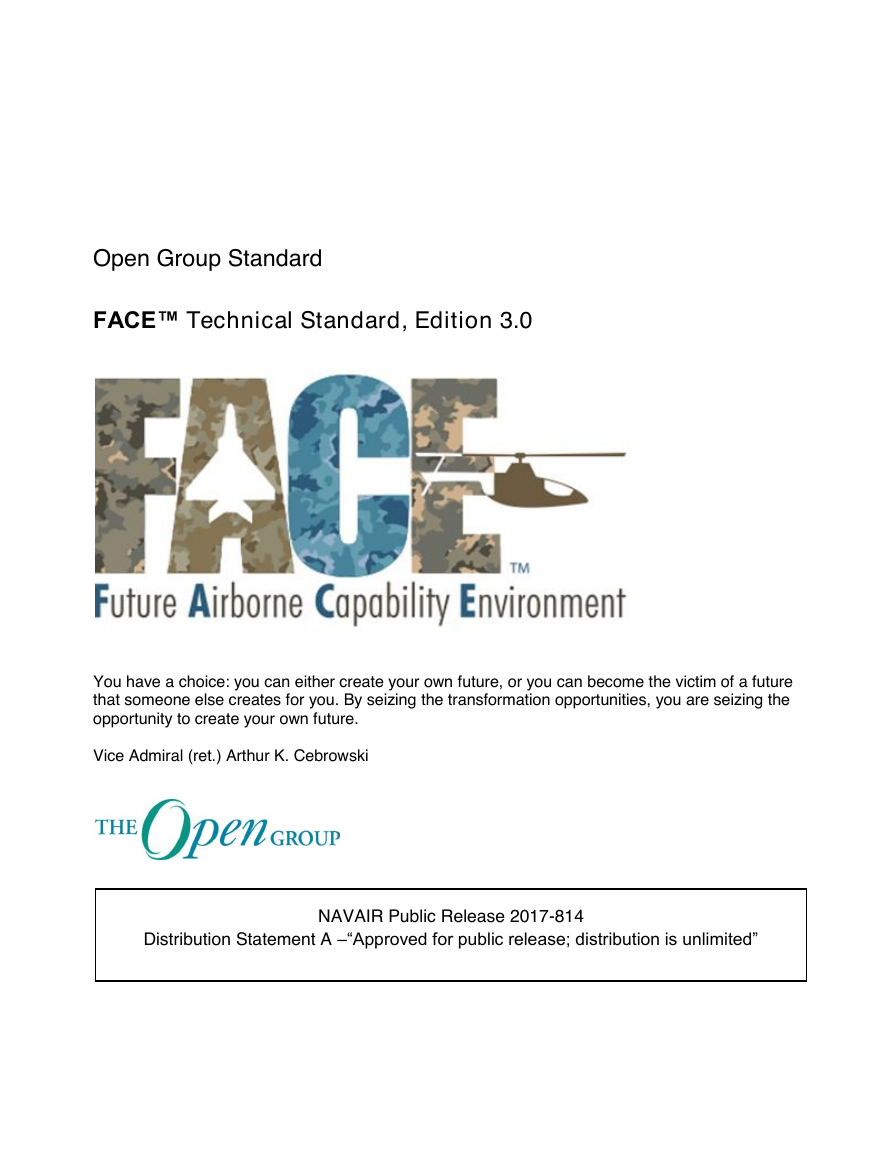
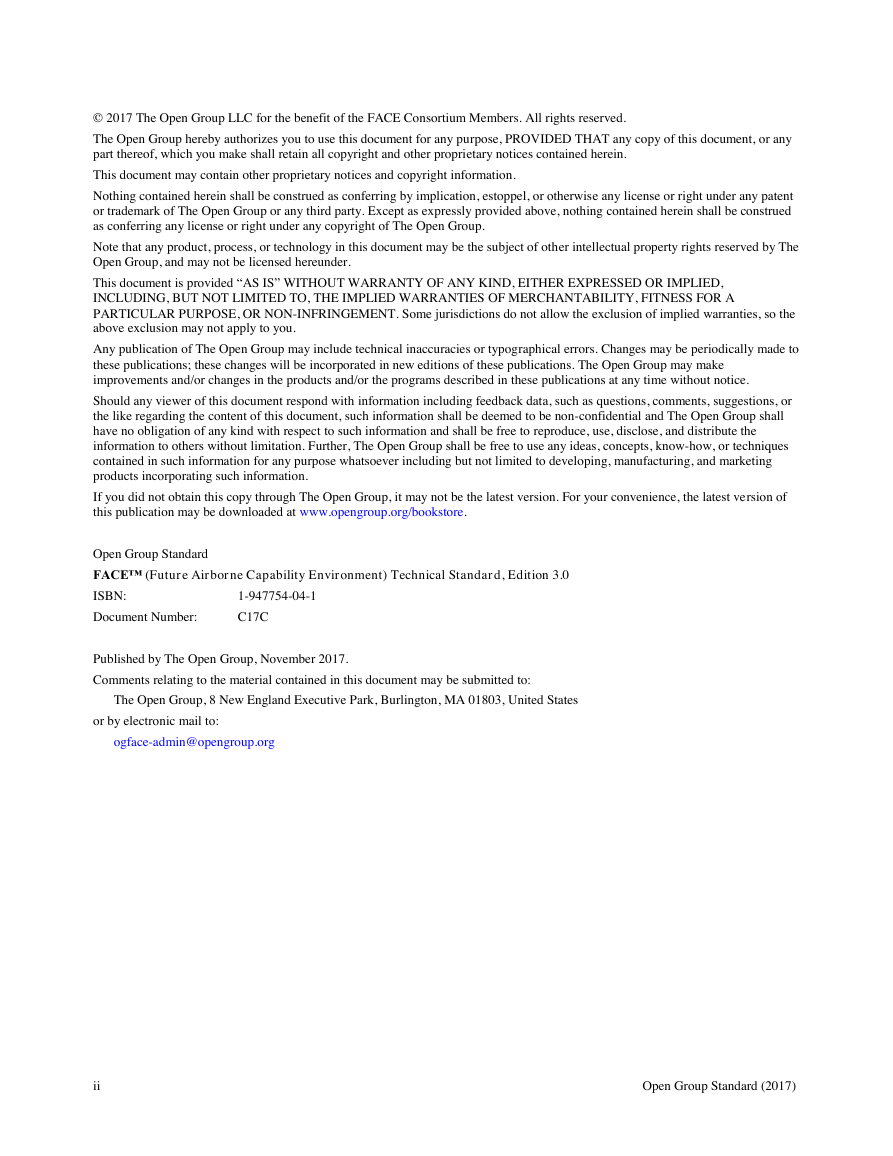
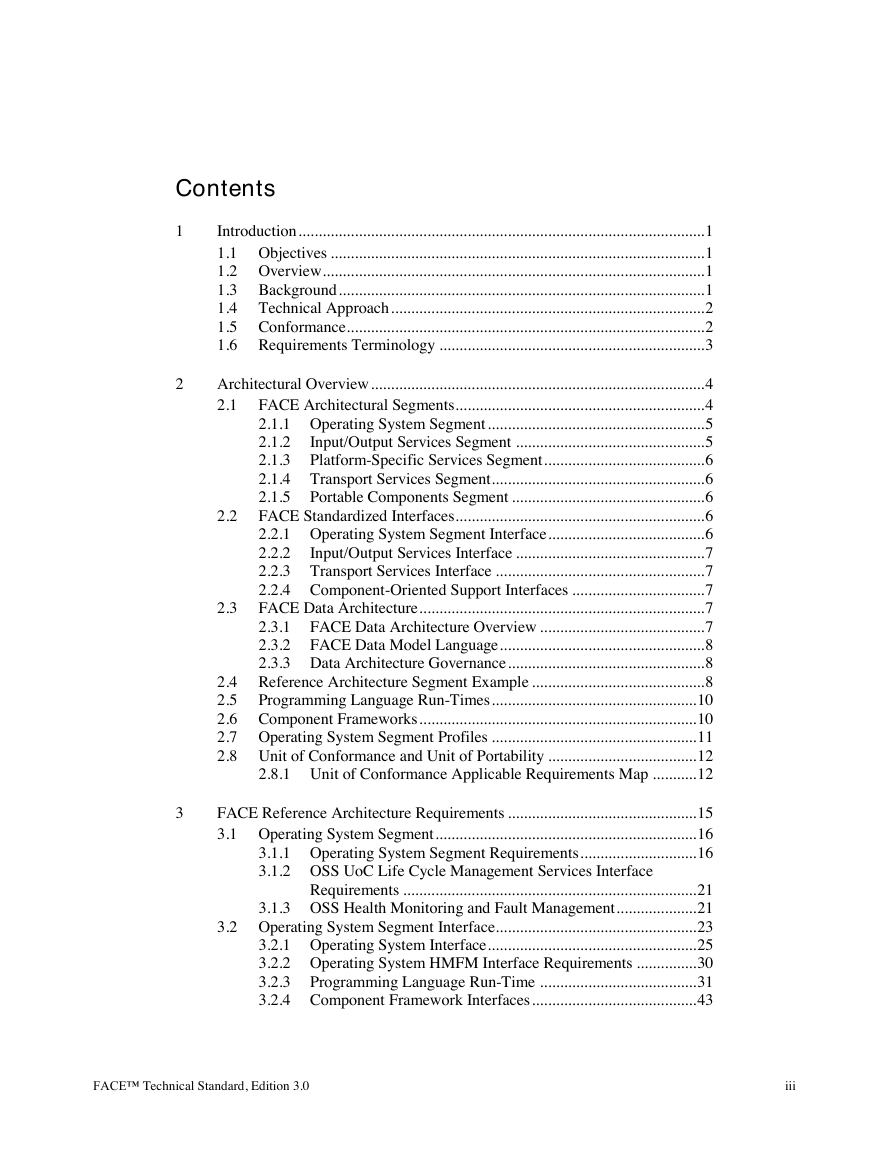
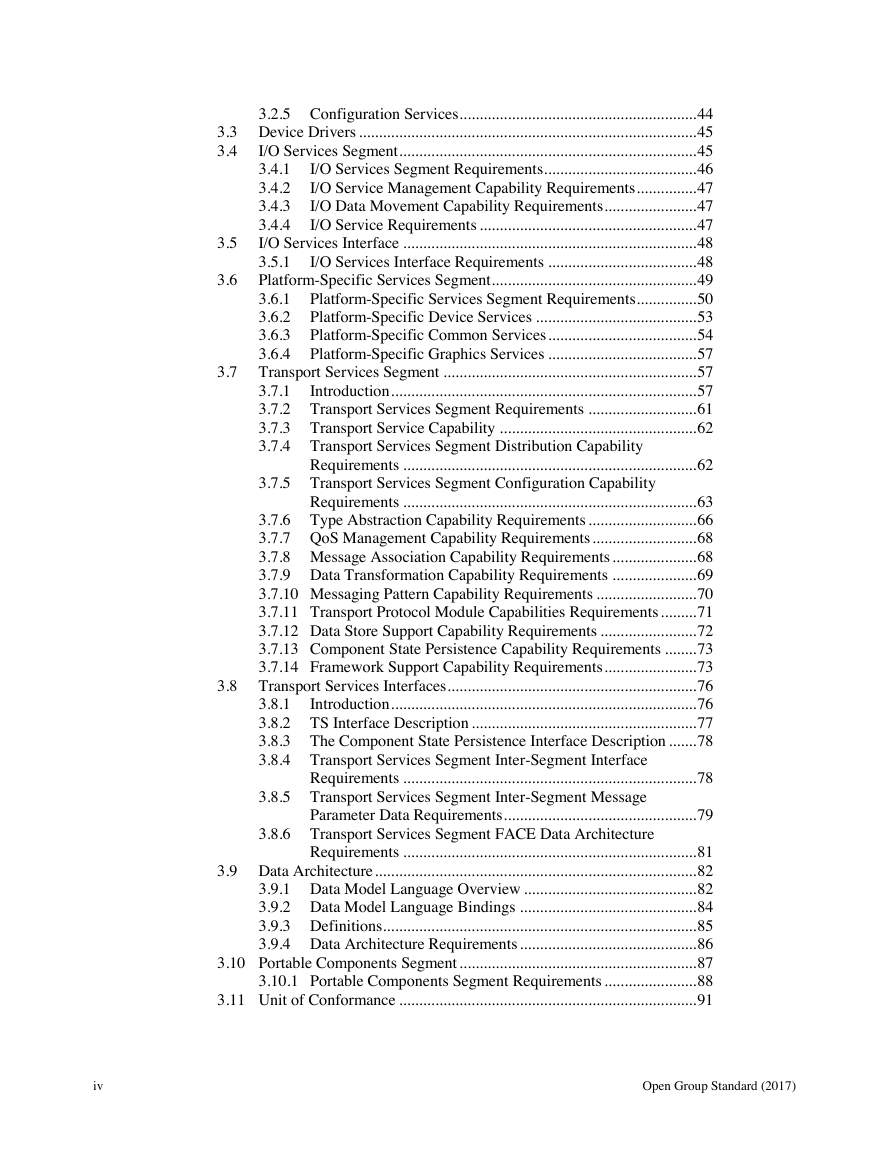
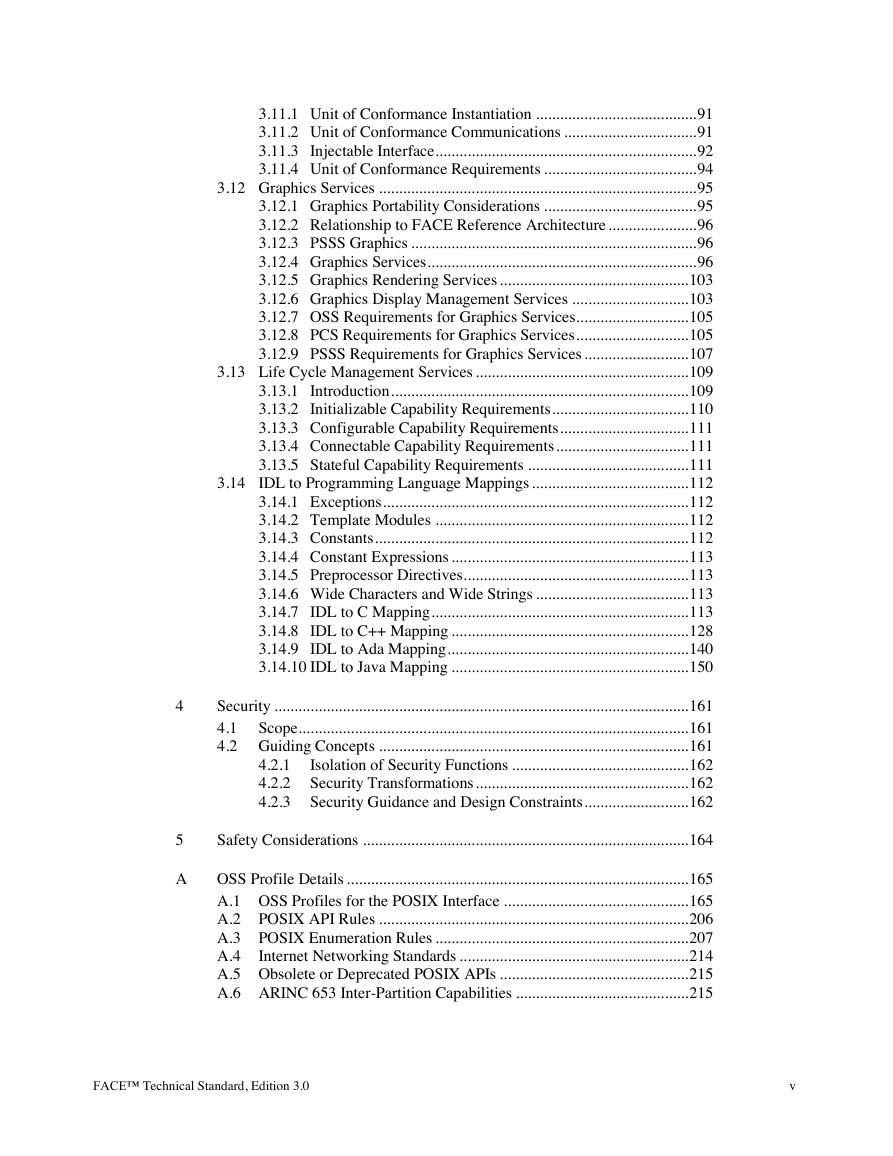
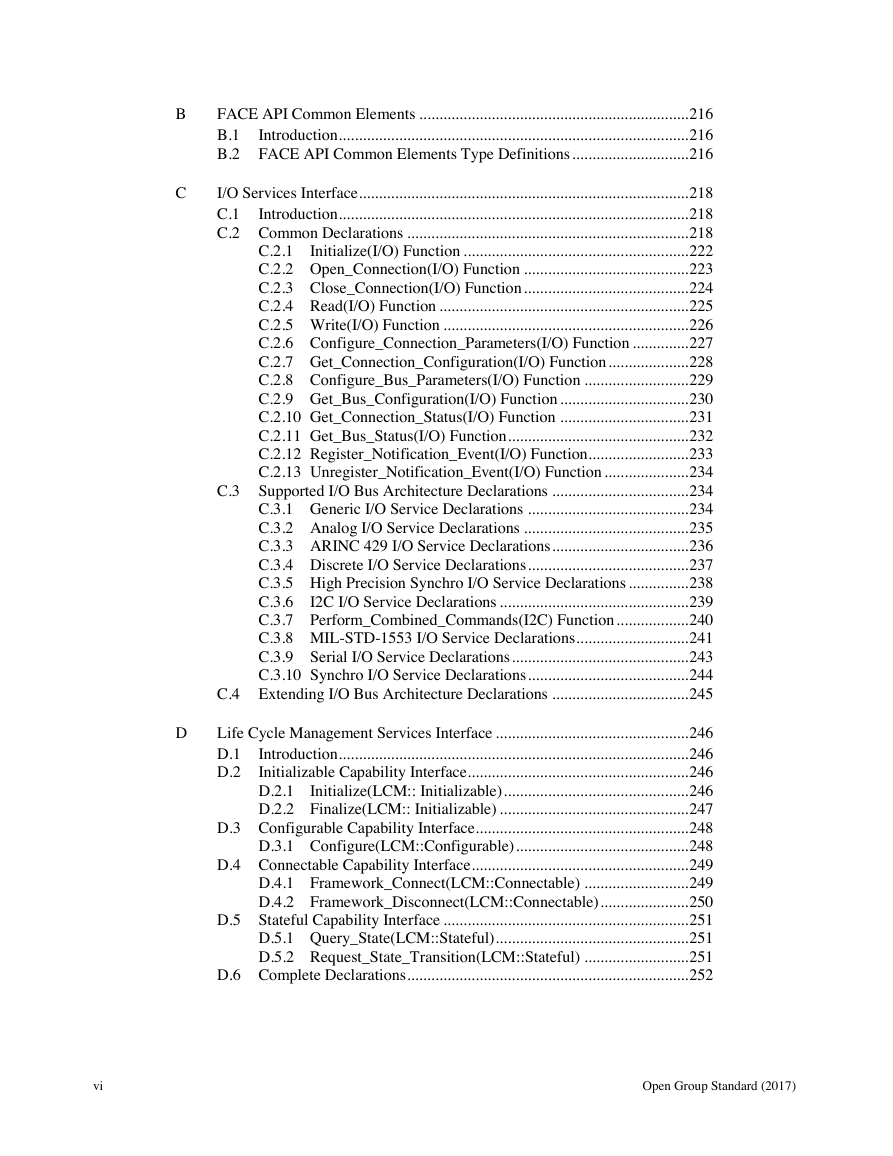
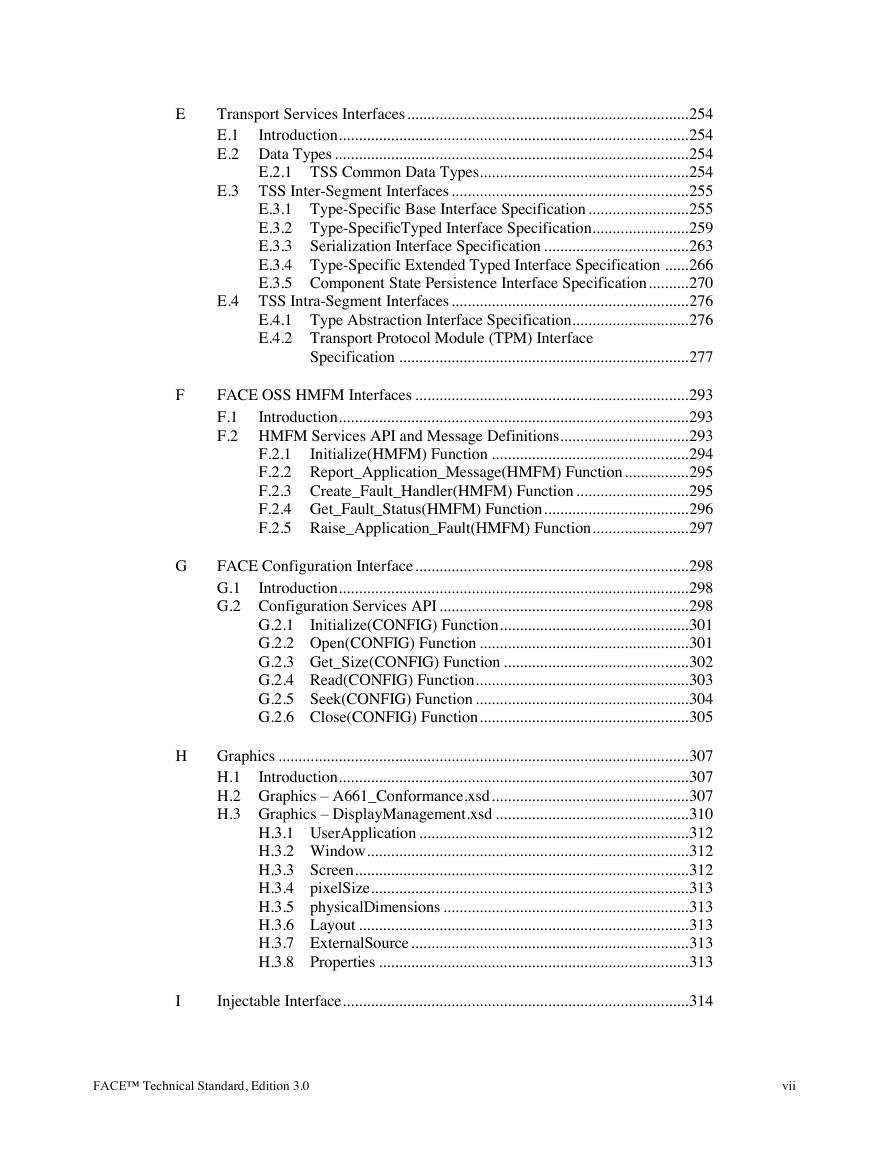









 2023年江西萍乡中考道德与法治真题及答案.doc
2023年江西萍乡中考道德与法治真题及答案.doc 2012年重庆南川中考生物真题及答案.doc
2012年重庆南川中考生物真题及答案.doc 2013年江西师范大学地理学综合及文艺理论基础考研真题.doc
2013年江西师范大学地理学综合及文艺理论基础考研真题.doc 2020年四川甘孜小升初语文真题及答案I卷.doc
2020年四川甘孜小升初语文真题及答案I卷.doc 2020年注册岩土工程师专业基础考试真题及答案.doc
2020年注册岩土工程师专业基础考试真题及答案.doc 2023-2024学年福建省厦门市九年级上学期数学月考试题及答案.doc
2023-2024学年福建省厦门市九年级上学期数学月考试题及答案.doc 2021-2022学年辽宁省沈阳市大东区九年级上学期语文期末试题及答案.doc
2021-2022学年辽宁省沈阳市大东区九年级上学期语文期末试题及答案.doc 2022-2023学年北京东城区初三第一学期物理期末试卷及答案.doc
2022-2023学年北京东城区初三第一学期物理期末试卷及答案.doc 2018上半年江西教师资格初中地理学科知识与教学能力真题及答案.doc
2018上半年江西教师资格初中地理学科知识与教学能力真题及答案.doc 2012年河北国家公务员申论考试真题及答案-省级.doc
2012年河北国家公务员申论考试真题及答案-省级.doc 2020-2021学年江苏省扬州市江都区邵樊片九年级上学期数学第一次质量检测试题及答案.doc
2020-2021学年江苏省扬州市江都区邵樊片九年级上学期数学第一次质量检测试题及答案.doc 2022下半年黑龙江教师资格证中学综合素质真题及答案.doc
2022下半年黑龙江教师资格证中学综合素质真题及答案.doc